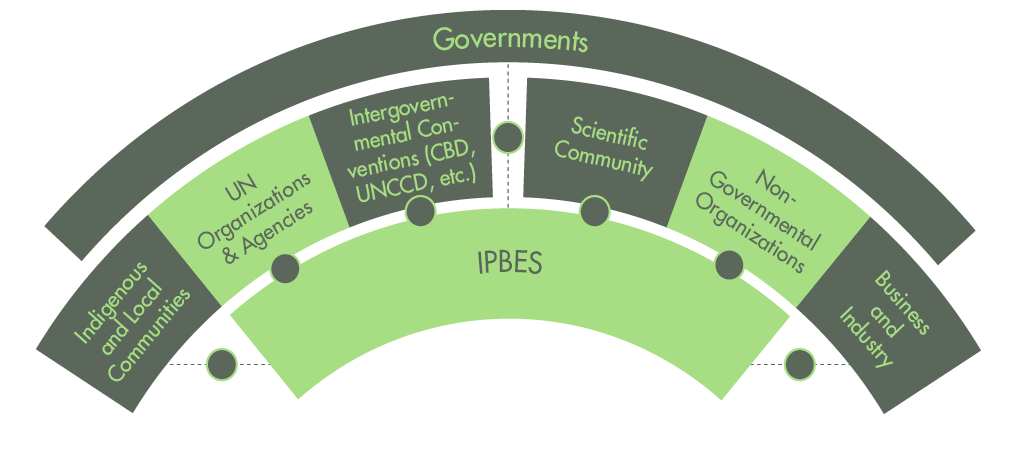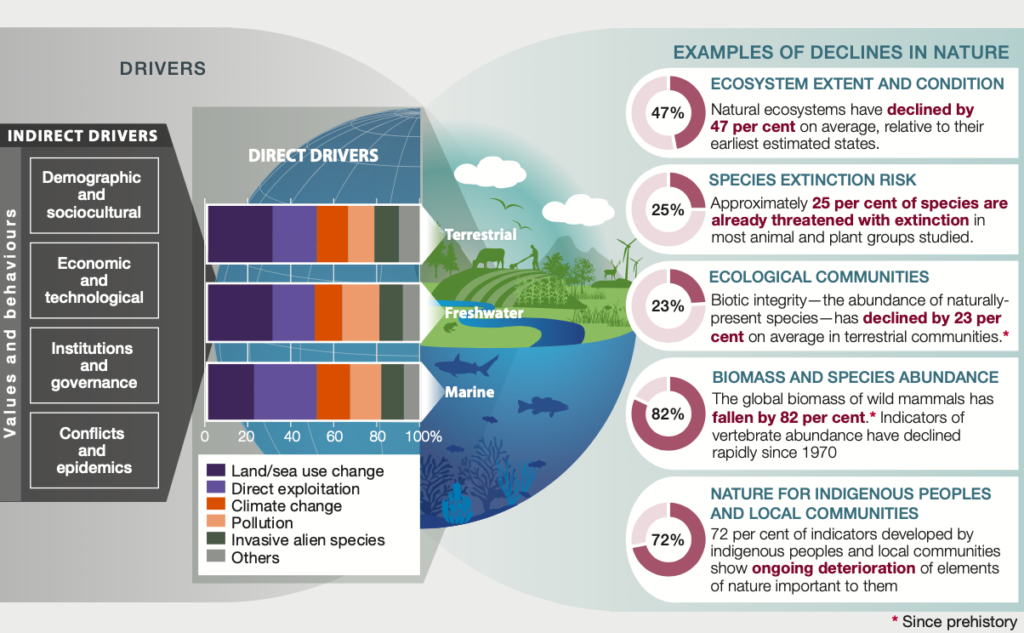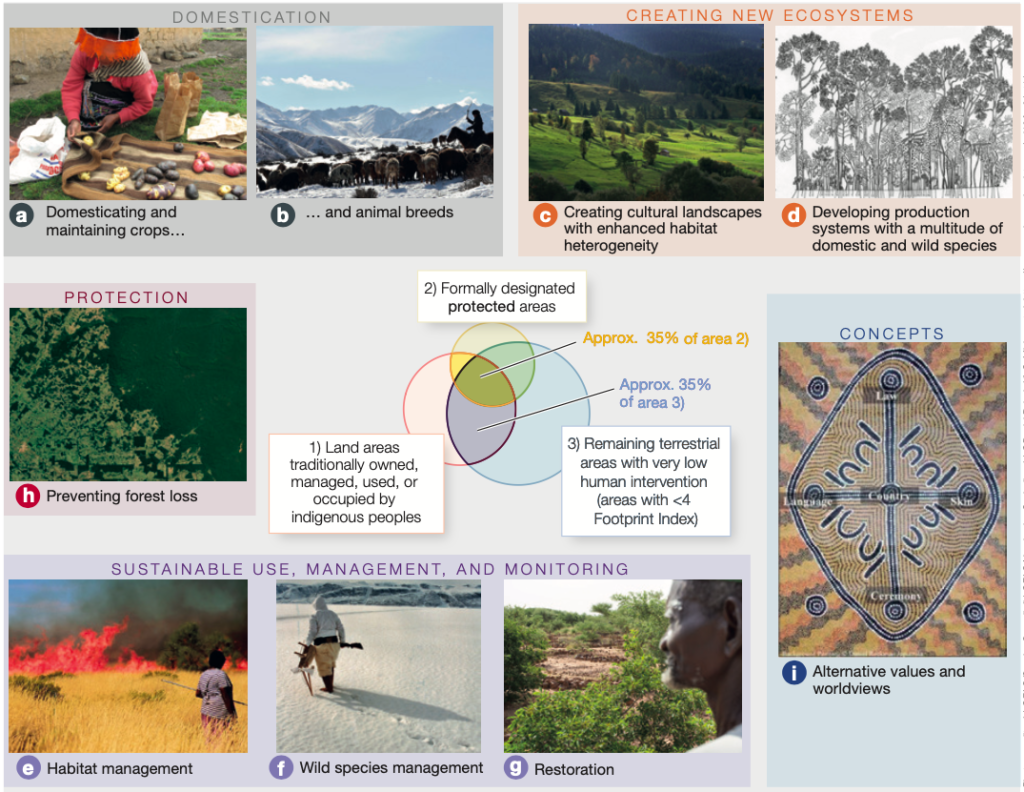ForumIAS announcing GS Foundation Program for UPSC CSE 2025-26 from 19 April. Click Here for more information.
ForumIAS Answer Writing Focus Group (AWFG) for Mains 2024 commencing from 24th June 2024. The Entrance Test for the program will be held on 28th April 2024 at 9 AM. To know more about the program visit: https://forumias.com/blog/awfg2024
Contents
- 1 Introduction
- 2 What is IPBES?
- 3 What does IPBES do?
- 4 About the IPBES Report
- 5 What are the Key Findings of the IPBES Assessment Report?
- 6 What are the reasons behind depletion of biodiversity?
- 7 What steps have been taken to protect Biodiversity?
- 8 What are the Recommendations of the IPBES Report?
- 9 What should be the approach going ahead?
- 10 Conclusion
| For 7PM Editorial Archives click HERE → |
Introduction
The Convention on Biological Diversity defines ‘sustainable use’ as the use of components of biological diversity in a way and at a rate that does not lead to the long-term decline of biological diversity. This would help in maintaining its potential to meet the needs and aspirations of present and future generations. The recently released Intergovernmental Science-Policy Platform on Biodiversity and Ecosystem Services (IPBES) Report offers insights, analysis and tools for sustainable use of wild species. The Report reminds the global community how much human beings are interdependent with all living beings and why it’s important to conserve them. The report comes against the backdrop of the stark findings of the IPBES in May, 2019 that shows around 1 million animal and plant species are threatened with extinction.
What is IPBES?
The Intergovernmental Science-Policy Platform on Biodiversity and Ecosystem Services (IPBES) is an independent intergovernmental body. It aims to strengthen the science-policy interface for biodiversity and ecosystem services for the conservation and sustainable use of biodiversity, long-term human well-being and sustainable development.
It was established in Panama City, on 21 April 2012 by 94 countries. It is not a United Nations body. However, at the request of the IPBES Plenary and with the authorization of the UNEP Governing Council in 2013, the United Nations Environment Programme (UNEP) provides secretariat services to IPBES.
It currently has close to 140 member States. A large number of NGOs, organizations, conventions and civil society groupings also participate in the formal IPBES process as observers.
Source: IPBES
What does IPBES do?
The work of IPBES can be broadly grouped into four complementary areas:
Assessments: On specific themes (e.g. “Pollinators, Pollination and Food Production”); methodological issues (e.g. “Scenarios and Modelling); and at both the regional and global levels (e.g. “Global Assessment of Biodiversity and Ecosystem Services”).
Policy Support: Identifying policy-relevant tools and methodologies, facilitating their use, and catalyzing their further development.
Building Capacity & Knowledge: Identifying and meeting the priority capacity, knowledge and data needs of our member States, experts and stakeholders.
Communications & Outreach: Ensuring the widest reach and impact of IPBES’s work.
About the IPBES Report
The report identifies five broad categories of ‘practices’ in the use of wild species: Fishing; Gathering; Logging; Terrestrial Animal Harvesting (including hunting); and Non-extractive practices, such as observing. For each practice, it examines specific ‘uses’ such as for food and feed; materials; medicine, energy; recreation; ceremony; learning and decoration.
It provides a detailed analysis of the trends in each, over the past 20 years. It indicated the increasing use of wild species but added that its sustained use has been varied.
What are the Key Findings of the IPBES Assessment Report?
Dependence on Biodiversity
Around 70% of the world’s poor are directly dependent on wild species. 50,000 wild species of plants, animals, fungi and algae meet the needs of billions of people globally.One in five people rely on wild species for income and food.
Around 2.4 billion people worldwide rely on wood for cooking and 880 million, particularly in developing countries, log firewood or produce charcoal. Logging for energy accounts for 50% of all wood consumed globally, and 90% of timber harvested in Africa. Even though the use of wood for fuel is declining in most regions, it is increasing in sub-Saharan Africa.
Certain species have cultural importance as they offer multiple benefits that define tangible and intangible features of people’s cultural heritage.
The use of wild species is also a source of culturally meaningful employment for such communities and they have engaged in the trade of wild species and materials since millennia.
Threat to Biodiversity
The global rate of species extinction is already at least tens to hundreds of times higher than the average rate over the past 10 million years and is accelerating.
Around 12% of tree species in the wild and 1,341 wild mammal species globally are threatened by unsustainable logging and hunting. More than 25% of the world’s forests are subject to industrial logging.
Unsustainable gathering is one of the main threats for several plant groups, notably cacti, cycads, and orchids as well as other plants.
Around 34% of marine wild fish stocks in the world are overfished. Further, Bycatch has led to a steep decline in the number of sharks and ray species since the 1970s.
Bycatch refers to incidental capture and mortality of non-target marine animals during fishing.
The report noted that indigenous people and local communities used local knowledge, practices and spirituality for the sustainable use of wild species. They respected nature and only took what they needed. This ensured that healthy populations of wild species were maintained.
What are the reasons behind depletion of biodiversity?
First, overexploitation is the primary reason for the depletion of biodiversity. The rate of usage is much more than the replenishment rate that has pushed many species on the verge of extinction.
Second, it assessed that changes in climate, sea and landscapes, pollution and invasive alien species impact the abundance and distribution of wild species.
Third, trade in wild plants, algae and fungi for food, medicine, hygiene, energy and ornamental use is increasing. Further, the illegal trade in wild species, worth up to US$ 199 billion annually, accounts for the world’s third largest class of illegal trade. Timber and fish make up the largest volumes and value of illegal trade in wild species.
Fourth, with lack of alternatives, people are often forced to further exploit wild species already at risk. For instance, due to lack of alternatives, still 2.4 billion people rely on fuelwood for cooking.
Source: IPBES Report. Drivers of Decline in Nature. The direct drivers (land-/sea-use change; direct exploitation of organisms; climate change; pollution; and invasive alien species) result from an array of underlying societal causes. These causes can be demographic (e.g., human population dynamics), sociocultural (e.g., consumption patterns), economic (e.g., trade), technological, or relating to institutions, governance, conflicts and epidemics. They are called indirect drivers and are underpinned by societal values and behaviours. Land- and sea-use change and direct exploitation account for more than 50% of the global impact on land, in fresh water and in the sea.
What steps have been taken to protect Biodiversity?
National
Wildlife Protection Act, 1972: It is an Act of the Parliament of India enacted for protection of plants and animal species. It has 6 schedules that provide varying degrees of protection to species.
Wildlife Crime Control Bureau (WCCB): It is a statutory multi-disciplinary body. It functions under the Ministry of Environment and Forests. Its responsibilities include combating organized wildlife crime in the country.
Global
IUCN Red List: It is a critical indicator of the health of the world’s biodiversity. Far more than a list of species and their status, it is a powerful tool to inform and catalyze action for biodiversity conservation and policy change.
Convention on International Trade in Endangered Species (CITES): It is an international agreement between governments. CITES regulates international trade in specimens of species of wild fauna and flora based on a system of permits and certificates issued under certain conditions.
Sustainable Development Goals: Countries have adopted 17 goals that need to be achieved by 2030. Many of them like SDG 13 (climate action), SDG 14 ( Life below water), SDG 15 (Life on land) etc.. focus on environment and species protection.
What are the Recommendations of the IPBES Report?
The Report observes that Nature can be conserved, restored and used sustainably while simultaneously meeting other global societal goals through urgent and concerted efforts fostering transformative change. The Sustainable Development Goals and the 2050 Vision for Biodiversity cannot be achieved without transformative change. Transformative change is facilitated by innovative governance approaches that incorporate integrative, inclusive, informed and adaptive governance.
Source: IPBES Report. Five main interventions (‘levers’) can generate transformative change by tackling the underlying drivers of the deterioration of nature: (1) Incentives and Capacity-building; (2) Cross-Sectoral Cooperation; (3) Pre-emptive Action; (4) Decision-making in the context of Resilience and Uncertainty; and (5) Environmental Law and Implementation.
Feeding humanity and enhancing the conservation and sustainable use of nature are complementary and closely interdependent goals. Both can be advanced through sustainable agriculture, aquaculture and livestock systems, the safeguarding of native species and habitats, and ecological restoration.
The Report observes that marine ecosystems and fisheries can be conserved through ecosystem-based approaches to fisheries management, effective quotas, marine protected areas, protecting and managing key marine biodiversity areas and reducing run-off pollution into oceans. Urgent steps are necessary to prevent, deter and eliminate illegal and unregulated fishing.
The Report emphasises on cost-effective nature-based solutions for meeting the Sustainable Development Goals in cities. This is crucial for global sustainability. Increased use of green infrastructure can help to advance sustainable urban development. Sustainable solutions include retrofitting green and blue infrastructure, creating and maintaining green spaces and biodiversity-friendly water bodies, urban agriculture, vegetation cover in existing urban and peri-urban areas and new developments. Green infrastructure will help in flood protection, temperature regulation, cleaning of air and water, locally sourced food and health benefits etc.
The IPBES Report emphasises that recognition of the knowledge, innovations, and practices of indigenous peoples and local communities can help in conservation, restoration and sustainable use of nature. Ensuring their inclusion and participation in environmental governance will enhance their quality of life.
Source: IPBES Report. Traditional knowledge helps in conservation through measures like habitat management, wild species managements, restoration measures, preventing forest loss etc.
Finally, the Report calls for a change in the global financial and economic systems that have a narrow view of economic growth. Focus has to be on reducing inequalities, overconsumption and waste and addressing environmental impacts. It would entail a shift beyond standard economic indicators such as GDP to include those able to capture more holistic, long-term views of quality of life.
What should be the approach going ahead?
First, the local communities should be made a key stakeholder in management of wildlife resources. The Government should ensure that their traditional knowledge is judiciously used to ensure sustainable usage of wild species. In this regard, effective implementation of the Forests Rights Act, 2006 is a must.
Second, the Government must ensure that environmental litigation is strengthened by establishing more benches of National Green Tribunals across the country. This will promote environmental consciousness and encourage people to file complaints against the violators.
Conclusion
Addressing the causes of unsustainable use and, wherever possible, reversing these trends should be the priority of Governments at Local, National and International level. This will result in better outcomes for wild species and the people who depend on them thereby moving towards attainment of sustainable development.
Source: Down to Earth, Down to Earth, Indian Express, The Times of India, IPBES








